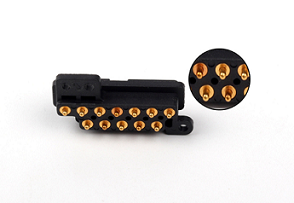What is a pogo pin connector used for ?
A Pogo Pin connector, also known as a spring-loaded connector or spring contact probe, is a specialized electrical connector designed for applications requiring reliable, compact, and repeatable electrical connections. Comprising three primary components—a plunger (needle), a barrel (tube), and a spring—this connector leverages spring force to maintain stable contact between surfaces, even in dynamic or vibration-prone environments.
Below, we explore its structure, working principles, key applications, advantages, and design considerations in detail.
1. Structure and Components
A
Pogo Pin connector consists of three precision-engineered parts:
• Plunger (Needle):The conductive tip, typically made of brass or beryllium copper, plated with gold or nickel for corrosion resistance and low electrical impedance. The plunger's base often features a sloped design to ensure consistent contact with the barrel's inner wall, optimizing current flow.
• Barrel (Tube):A hollow cylindrical component that houses the plunger and spring. Like the plunger, it is usually brass-based and gold-plated to minimize resistance and enhance durability.
• Spring:A stainless steel (SUS304) or music wire component that provides the mechanical force to maintain contact pressure between the plunger and the mating surface.
The assembly is crimped using high-precision machinery to ensure alignment and longevity
2. Working Principles
The Pogo Pin connector operates through three core mechanisms:
1. Spring Force:The spring exerts a controlled pressure, ensuring the plunger maintains physical and electrical contact with the target surface. This force remains stable even after thousands of compression cycles, critical for high-durability applications.
2. Electrical Pathway:Current flows from the plunger to the barrel via their gold-plated surfaces, minimizing resistance (typically <50mΩ) and ensuring stable signal or power transmission.
3. Self-Cleaning Action:Repeated compression cycles gently scrub the contact surfaces, reducing oxidation and contamination that could degrade performance.
3. Key Applications
Pogo Pin connectors are widely used in industries demanding precision, compactness, and reliability:
3.1 Consumer Electronics
• Smartphones and Wearables: Enables charging, data transfer, and antenna connections in ultra-thin devices like smartwatches and foldable phones. For example, Apple’s Mag Safe charger uses Pogo Pins for alignment and power delivery.
• Laptops and Tablets:Facilitates docking station connections and modular component swaps (e.g., detachable keyboards).
3.2 Medical Devices
• Diagnostic Equipment:Provides temporary connections for disposable sensors (e.g., glucose monitors) or portable ultrasound probes, ensuring hygiene and reliability.
• Implantable Devices:Used in non-invasive programming tools for pacemakers and neurostimulators.
3.3 Automotive and Aerospace
• In-Vehicle Systems:Connects infotainment modules, sensors, and battery management systems (BMS) in electric vehicles (EVs).
• Satellites and UAVs: Withstands extreme temperatures and vibrations in space-grade applications.
3.4 Industrial Automation
• Robotics:Enables quick-change tooling interfaces for collaborative robots (cobots).
• PCB Testing:Serves as test points for in-circuit testing (ICT) and firmware updates.
4. Advantages Over Traditional Connectors
Pogo Pin connectors offer distinct benefits:
1. High Durability:Rated for 50,000–100,000 cycles, outperforming most solder-based or friction-fit connectors.
2. Space Efficiency:Miniature designs (e.g., 0.6mm diameter) save weight and space in compact devices.
3. Low Maintenance:Self-cleaning action reduces the need for manual intervention.
4. Environmental Resistance:Gold plating and sealed designs withstand humidity, dust, and temperature extremes (-40°C to +125°C)46.
5. Rapid Prototyping:Standardized designs shorten development cycles compared to custom connectors.
5. Design Considerations
To optimize performance, engineers must address:
5.1 Contact Force and Travel
• Force:Typically 50–500g, balancing retention and wear. Excessive force accelerates spring fatigue; insufficient force risks intermittent connections.
• Travel Distance:The plunger’s compression range (e.g., 0.5–2.0mm) must align with mating tolerances.
5.2 Material Selection
• Plunger/Barrel:Gold plating (0.1–0.5µm) ensures low resistance and corrosion resistance. Nickel underplating (1.25–2.5µm) enhances wear resistance.
• Spring:Stainless steel (SUS304) or high-carbon music wire for consistent elasticity.
5.3 Environmental Factors
• Sealing:IP67-rated designs with O-rings or over molding prevent moisture ingress.
• Thermal Management:High-current applications (e.g., EV charging) may require heat-dissipating materials like phosphor bronze.
6. Common Challenges and Solutions
6.1 Intermittent Connections (Transient Disconnects)
• Cause:Contamination, worn springs, or misalignment.
• Solutions:
• Increase contact points (e.g., multi-plunger designs).
• Use anti-oxidation coatings (e.g., palladium-nickel).
• Implement self-aligning housings to compensate for mating errors.
6.2 High-Current Applications
• Limitation:Standard Pogo Pins handle 1–5A; higher currents risk overheating.
• Mitigation:
• Oversize pins with thicker plating (e.g., 2.0µm gold).
• Parallel multiple pins for current sharing.
7. Future Trends
1. Miniaturization:Sub-0.4mm pins for AR/VR devices and micro-medical implants.
2. High-Speed Data:Shielded designs supporting USB4 (40Gbps) and Thunderbolt.
3. Sustainability:Lead-free materials (e.g., tin-zinc plating) compliant with RoHS/REACH.
Cnomax Pogo pin engineer Conclusion:
Pogo Pin connectors are indispensable in modern electronics, bridging the gap between miniaturization and reliability. Their versatility spans consumer gadgets, life-saving medical tools, and cutting-edge aerospace systems. By adhering to rigorous design principles—optimizing contact force, material selection, and environmental protection—engineers can harness their full potential. As technology advances toward smaller, faster, and more connected devices, Pogo Pins will remain a cornerstone of innovative electrical interfacing
